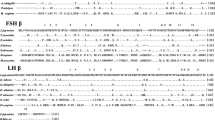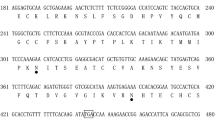Abstract:
Gonadotropins are important regulators of reproduction. To develop molecular resources for production of recombinant gonadotropins, we have cloned and sequenced complementary DNA encoding the channel catfish (Ictalurus punctatus) follicle-stimulating hormone (FSH) and luteinizing hormone (LH), which encode 132 and 140 amino acid proteins, respectively. The deduced amino acid sequences of the catfish FSH and LH are highly conserved with those cloned from other teleosts. Both the FSH and the LH were highly induced during ovulation after injection of carp pituitary extract. Taken together with our previous findings of enhanced expression of growth hormone and other pituitary hormones, this research suggests that a hormonal cocktail may be needed for more efficient manipulation of catfish reproduction. The availability of the catfish FSH and LH cDNAs provides the opportunity for production of immunologically or biologically active recombinant gonadotropins for the study of catfish reproductive physiology and the manipulation of artificial spawning for aquaculture.
Similar content being viewed by others
Author information
Authors and Affiliations
Additional information
Received March 12, 2001; accepted June 27, 2001
Rights and permissions
About this article
Cite this article
Liu, Z., Kim, S. & Karsi, A. Channel Catfish Follicle-Stimulating Hormone and Luteinizing Hormone: Complementary DNA Cloning and Expression During Ovulation. Mar. Biotechnol. 3, 590–599 (2001). https://doi.org/10.1007/s1012601-0067-5
Issue Date:
DOI: https://doi.org/10.1007/s1012601-0067-5




